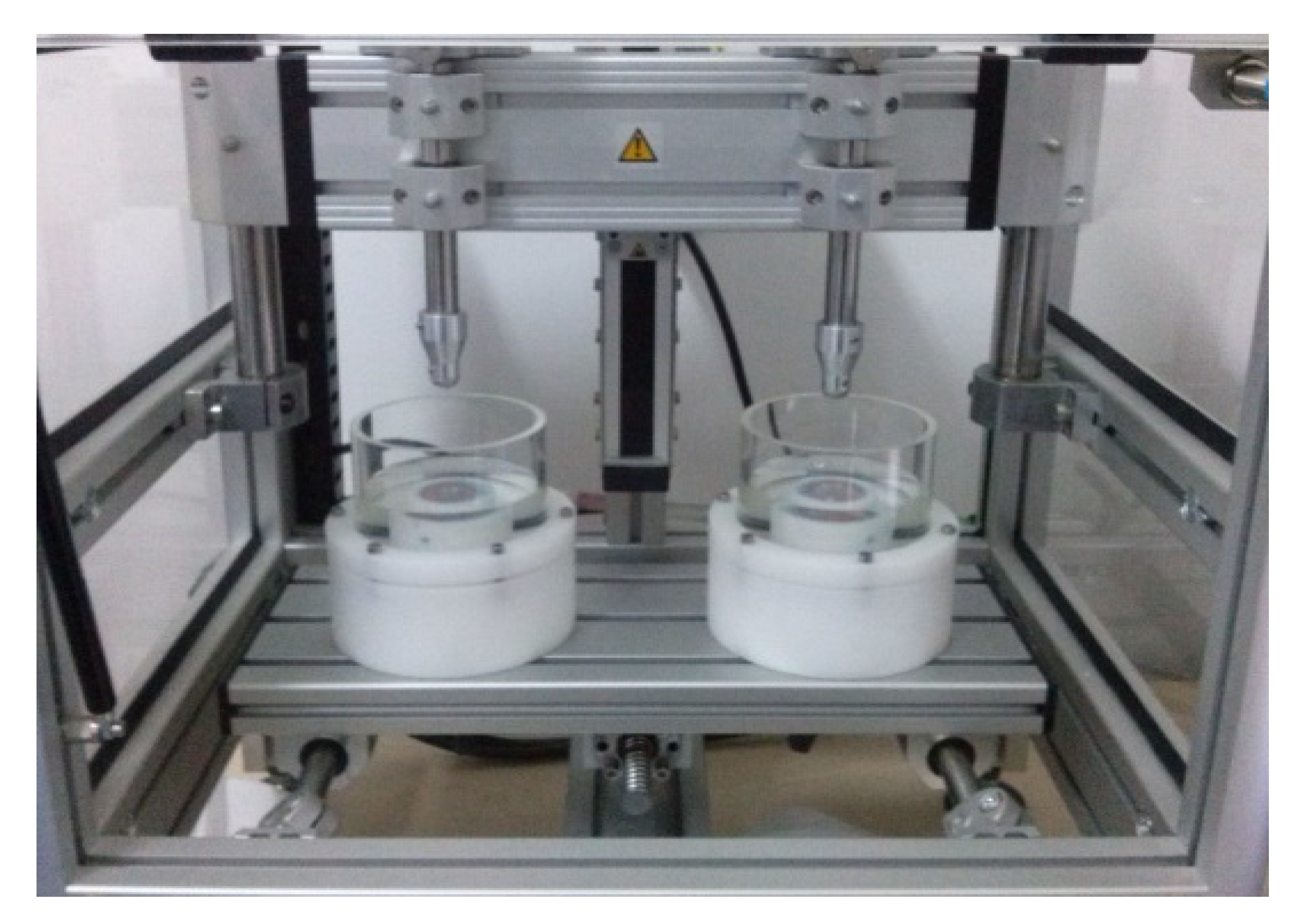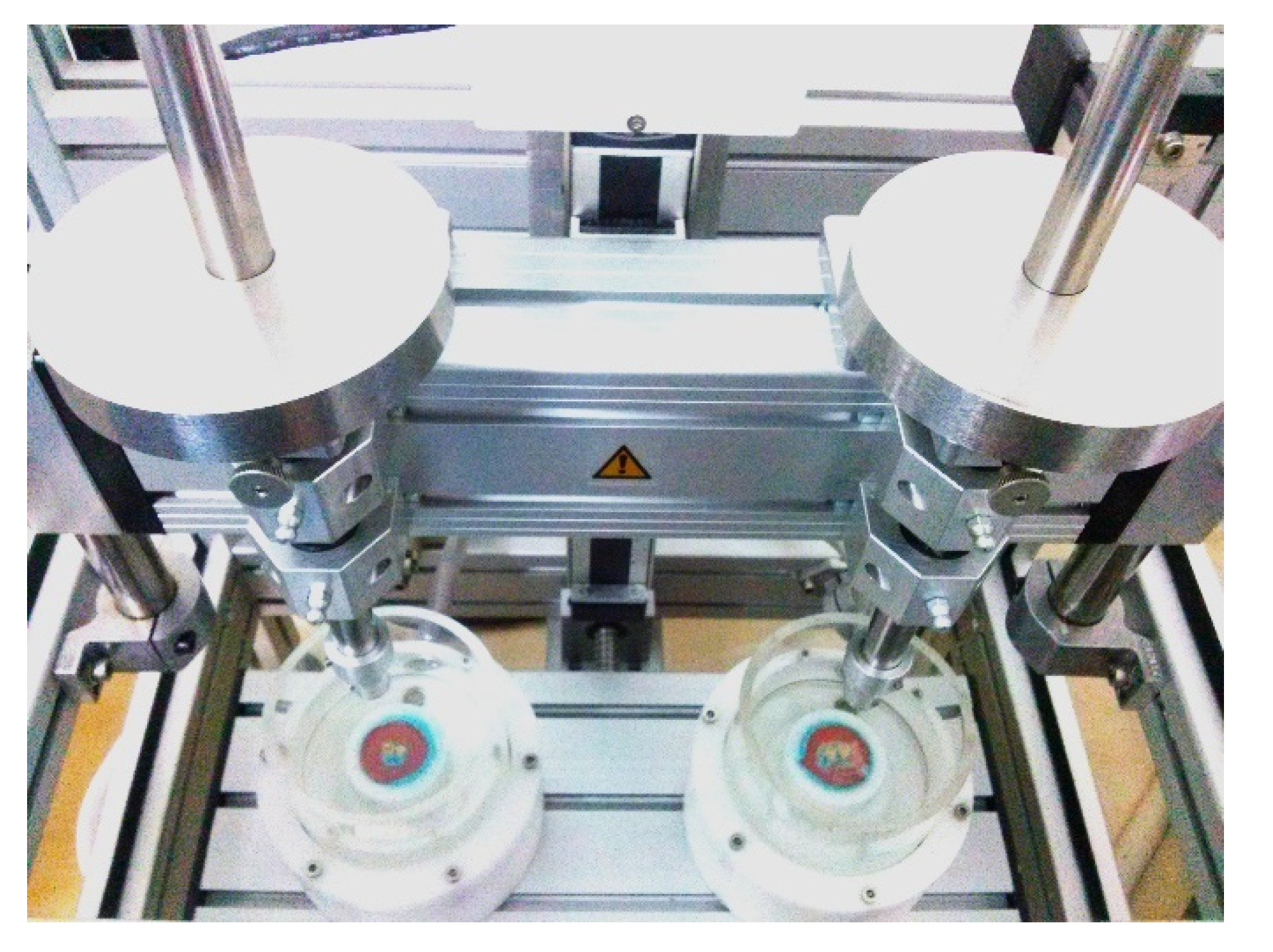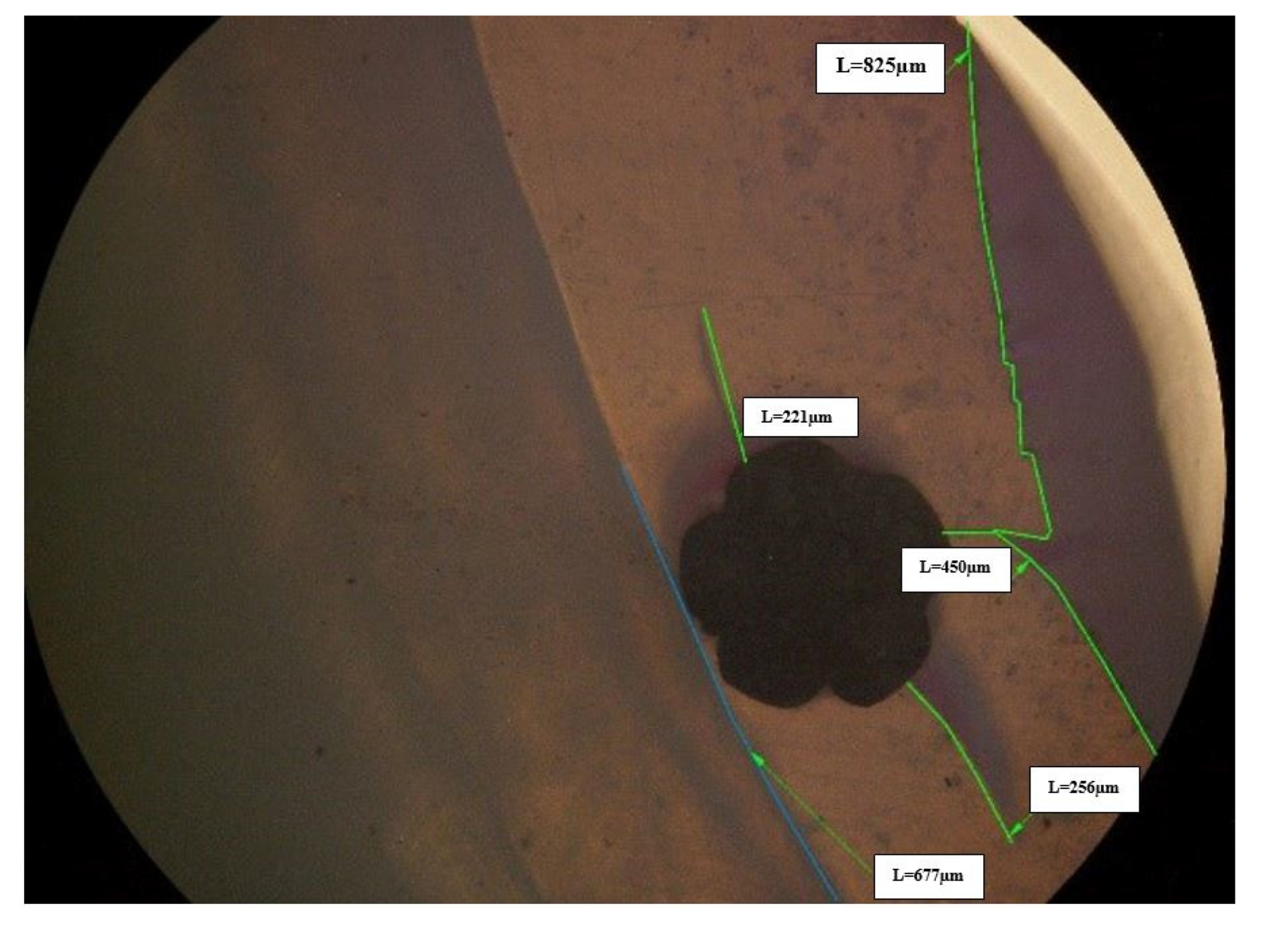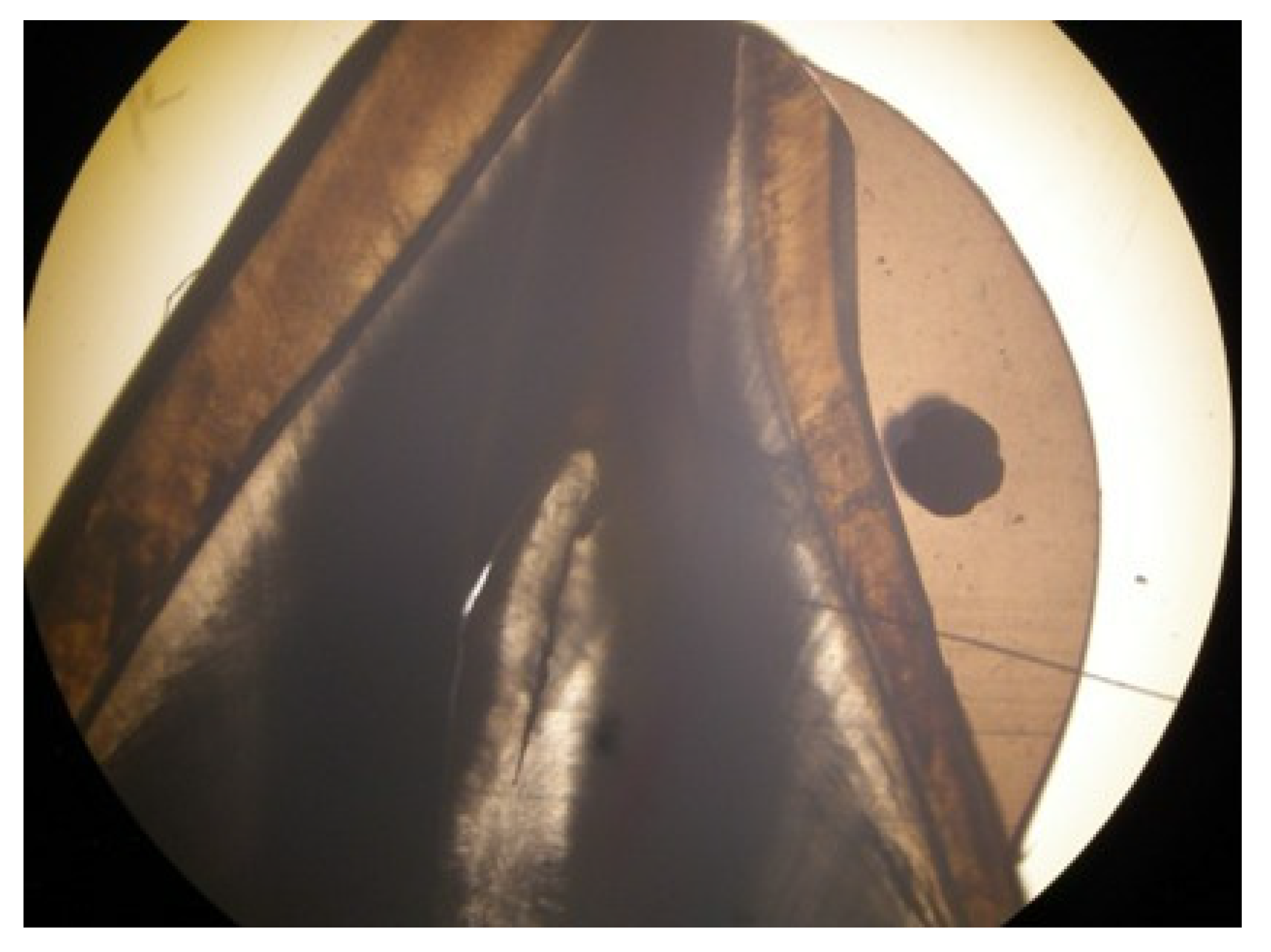Bruxism’s Implications on Fixed Orthodontic Retainer Adhesion
Abstract
:1. Introduction
2. Materials and Methods
2.1. Preparation of Teeth
2.2. Preparation of Samples
2.3. Testing the Samples
2.4. Sample Analysis
2.5. Statistical Analysis
3. Results
4. Discussion
4.1. Limitations and Strengths
4.2. Future Directions
5. Conclusions
Author Contributions
Funding
Institutional Review Board Statement
Informed Consent Statement
Data Availability Statement
Conflicts of Interest
References
- Kirschen, R.; Littlewood, S.J.; Blazewska-Amin, A.; Fleming, P.S. Bonded Orthodontic Retention: A Practical Guide. Br. Dent. J. 2021, 230, 709–716. [Google Scholar] [CrossRef] [PubMed]
- Kartal, Y.; Kaya, B. Fixed Orthodontic Retainers: A Review. Turk. J. Orthod. 2019, 32, 110–114. [Google Scholar] [CrossRef] [PubMed]
- Chinvipas, N.; Hasegawa, Y.; Terada, K. Repeated Bonding of Fixed Retainer Increases the Risk of Enamel Fracture. Odontology 2014, 102, 89–97. [Google Scholar] [CrossRef] [PubMed]
- Al-Dboush, R.; Al-Zawawi, E.; El-Bialy, T. Do Orthodontic Fixed Retainers Guarantee the Stability of Dental Alignment at the End of Orthodontic Treatment? Evid. Based Dent. 2021, 22, 148–149. [Google Scholar] [CrossRef] [PubMed]
- Labunet, A.V.; Badea, M. In Vivo Orthodontic Retainer Survival—A Review. Med. Pharm. Rep. 2015, 88, 298–303. [Google Scholar] [CrossRef] [Green Version]
- Golshah, A.; Amiri Simkooei, Z. Shear Bond Strength of Four Types of Orthodontic Retainers after Thermocycling and Cyclic Loading. Int. J. Dent. 2021, 2021, 9424040. [Google Scholar] [CrossRef]
- Khan, A.S.; Alshaia, A.; AlDubayan, A.; Alarifi, S.; Alamri, A.; Aldossary, H.; Ahmed, S.Z.; Ateeq, I.S.; Hakeem, A.S.; Rehman, S. Preparation of Nano-Apatite Grafted Glass-Fiber-Reinforced Composites for Orthodontic Application: Mechanical and In Vitro Biofilm Analysis. Materials 2022, 15, 3504. [Google Scholar] [CrossRef]
- Lavigne, G.J.; Khoury, S.; Abe, S.; Yamaguchi, T.; Raphael, K. Bruxism Physiology and Pathology: An Overview for Clinicians. J. Oral Rehabil. 2008, 35, 476–494. [Google Scholar] [CrossRef]
- Lobbezoo, F.; Ahlberg, J.; Glaros, A.G.; Kato, T.; Koyano, K.; Lavigne, G.J.; de Leeuw, R.; Manfredini, D.; Svensson, P.; Winocur, E. Bruxism Defined and Graded: An International Consensus. J. Oral Rehabil. 2013, 40, 2–4. [Google Scholar] [CrossRef]
- Lobbezoo, F.; Ahlberg, J.; Raphael, K.G.; Wetselaar, P.; Glaros, A.G.; Kato, T.; Santiago, V.; Winocur, E.; De Laat, A.; De Leeuw, R.; et al. International Consensus on the Assessment of Bruxism: Report of a Work in Progress. J. Oral Rehabil. 2018, 45, 837–844. [Google Scholar] [CrossRef]
- Reddy, S.V.; Kumar, M.P.; Sravanthi, D.; Mohsin, A.H.B.; Anuhya, V. Bruxism: A Literature Review. J. Int. Oral Health JIOH 2014, 6, 105–109. [Google Scholar] [PubMed]
- Manfredini, D.; Lombardo, L.; Vigiani, L.; Arreghini, A.; Siciliani, G. Effects of Invisible Orthodontic Retainers on Masticatory Muscles Activity during Sleep: A Controlled Trial. Prog. Orthod. 2018, 19, 24. [Google Scholar] [CrossRef] [PubMed] [Green Version]
- Bargellini, A.; Graziano, V.; Cugliari, G.; Deregibus, A.; Castroflorio, T. Effects on Sleep Bruxism Activity of Three Different Oral Appliances: One Year Longitudinal Cohort Study. Curr. Drug Deliv. 2022. [Google Scholar] [CrossRef]
- Brosh, T.; Zary, R.; Pilo, R.; Gavish, A. Influence of Periodontal Ligament Simulation and Splints on Strains Developing at the Cervical Area of a Tooth Crown. Eur. J. Oral Sci. 2012, 120, 466–471. [Google Scholar] [CrossRef] [PubMed]
- Leódido, G.d.R.; Fernandes, H.O.; Tonetto, M.R.; Presoto, C.D.; Bandéca, M.C.; Firoozmand, L.M. Effect of Fluoride Solutions on the Shear Bond Strength of Orthodontic Brackets. Braz. Dent. J. 2012, 23, 698–702. [Google Scholar] [CrossRef] [Green Version]
- Heintze, S.D. How to Qualify and Validate Wear Simulation Devices and Methods. Dent. Mater. Off. Publ. Acad. Dent. Mater. 2006, 22, 712–734. [Google Scholar] [CrossRef] [PubMed]
- Caracostea Objelean, A.; Labunet, A.; Silaghi-Dumitrescu, L.; Moldovan, M.; Sava, S.; Badea, M.E. In Vitro Chewing Simulation Model Influence on the Adhesive-Tooth Structure Interface. Key Eng. Mater. 2016, 695, 77–82. [Google Scholar] [CrossRef]
- Padmos, J.A.D.; Fudalej, P.S.; Renkema, A.M. Epidemiologic Study of Orthodontic Retention Procedures. Am. J. Orthod. Dentofac. Orthop. 2018, 153, 496–504. [Google Scholar] [CrossRef]
- Kocher, K.E.; Gebistorf, M.C.; Pandis, N.; Fudalej, P.S.; Katsaros, C. Survival of Maxillary and Mandibular Bonded Retainers 10 to 15 Years after Orthodontic Treatment: A Retrospective Observational Study. Prog. Orthod. 2019, 20, 28. [Google Scholar] [CrossRef]
- Ajlouni, R.; Bishara, S.E.; Soliman, M.M.; Oonsombat, C.; Laffoon, J.F.; Warren, J. The Use of Ormocer as an Alternative Material for Bonding Orthodontic Brackets. Angle Orthod. 2005, 75, 106–108. [Google Scholar] [CrossRef]
- Thekiya, A.H.; Aileni, K.R.; Rachala, M.R.; Reddy, S.D.; Devi, K.S.; Khan, M.Y.A. An Evaluation of Shear Bond Strength of Admira (Ormocer) as an Alternative Material for Bonding Orthodontic Brackets: An In Vitro Study. J. Int. Soc. Prev. Community Dent. 2018, 8, 56–61. [Google Scholar] [CrossRef] [PubMed]
- Sharma, S.; Padda, B.K.; Choudhary, V. Comparative Evaluation of Residual Monomer Content and Polymerization Shrinkage of a Packable Composite and an Ormocer. J. Conserv. Dent. JCD 2012, 15, 161–165. [Google Scholar] [CrossRef] [PubMed] [Green Version]
- Kumar, K.S.; Rao, C.H.; Reddy, K.B.; Chidambaram, S.; Girish, H.; Murgod, S. Flowable Composite an Alternative Orthodontic Bonding Adhesive: An in Vitro Study. J. Contemp. Dent. Pract. 2013, 14, 883–886. [Google Scholar] [CrossRef] [PubMed]
- Ilie, N.; Hickel, R. Investigations on Mechanical Behaviour of Dental Composites. Clin. Oral Investig. 2009, 13, 427–438. [Google Scholar] [CrossRef] [PubMed]
- Erickson, R.L.; Barkmeier, W.W.; Latta, M.A. The Role of Etching in Bonding to Enamel: A Comparison of Self-Etching and Etch-and-Rinse Adhesive Systems. Dent. Mater. Off. Publ. Acad. Dent. Mater. 2009, 25, 1459–1467. [Google Scholar] [CrossRef]
- Campanella, V.; Gallusi, G.; Nardi, R.; Mea, A.; Di Taranto, V.; Montemurro, E.; Marzo, G.; Libonati, A. Dentinal Substrate Variability and Bonding Effectiveness: SEM Investigation. J. Biol. Regul. Homeost. Agents 2020, 34, 49–54. [Google Scholar]
- Jedliński, M.; Mazur, M.; Schmeidl, K.; Grocholewicz, K.; Ardan, R.; Janiszewska-Olszowska, J. Orthodontic Retention-Protocols and Materials-A Questionnaire Pilot Study among Polish Practitioners. Materials 2022, 15, 666. [Google Scholar] [CrossRef]
- Paolone, M.G.; Kaitsas, R.; Obach, P.; Kaitsas, V.; Benedicenti, S.; Sorrenti, E.; Barberis, F. Tensile Test and Interface Retention Forces between Wires and Composites in Lingual Fixed Retainers. Int. Orthod. 2015, 13, 210–220. [Google Scholar] [CrossRef] [PubMed]
- Al-Nimri, K.; Al-Nimri, J. Shear Bond Strength of Different Fixed Orthodontic Retainers. Aust. Orthod. J. 2015, 31, 178–183. [Google Scholar] [CrossRef]
- Tabrizi, S.; Salemis, E.; Usumez, S. Flowable Composites for Bonding Orthodontic Retainers. Angle Orthod. 2010, 80, 195–200. [Google Scholar] [CrossRef]
- Uysal, T.; Sari, Z.; Demir, A. Are the Flowable Composites Suitable for Orthodontic Bracket Bonding? Angle Orthod. 2004, 74, 697–702. [Google Scholar] [CrossRef] [PubMed]
- Pick, B.; Rosa, V.; Azeredo, T.R.; Cruz Filho, E.A.M.; Miranda, W.G. Are Flowable Resin-Based Composites a Reliable Material for Metal Orthodontic Bracket Bonding? J. Contemp. Dent. Pract. 2010, 11, E017–E024. [Google Scholar] [PubMed]
- Rahimi, H.; Albright, D.A.; Hughes, J.A.; Dutra, V.; Turkkahraman, H. Three-Dimensional Analysis of the Posttreatment Displacements of Mandibular Anterior Teeth with Rigid and Flexible Lingual Retainers. Am. J. Orthod. Dentofac. Orthop. 2022, 161, 628–637. [Google Scholar] [CrossRef] [PubMed]
- Laspos, C.; Seehra, J.; Katsaros, C.; Pandis, N. Survival of Conventionally Bonded Mandibular Retainers with or without Enamel Sandblasting in Orthodontic Patients over a 12-Month Period. A Single-Centre, Split-Mouth Randomized Clinical Trial. Eur. J. Orthod. 2022, cjac028. [Google Scholar] [CrossRef]
- Cornelis, M.A.; Egli, F.; Bovali, E.; Kiliaridis, S.; Cattaneo, P.M. Indirect vs Direct Bonding of Mandibular Fixed Retainers in Orthodontic Patients: Comparison of Retainer Failures and Posttreatment Stability. A 5-Year Follow-up of a Single-Center Randomized Controlled Trial. Am. J. Orthod. Dentofac. Orthop. 2022, in press. [Google Scholar] [CrossRef]
- Chakraborty, M.; Singh, A.; Vadavadagi, S.V.; Kumari, A.; Prasad, R.S.; Anand, A. Evaluation of Microleakage Using Dye-Penetration Method in Three Different Composite Resin Core Build-up Materials: An In Vitro Study. J. Contemp. Dent. Pract. 2022, 23, 61–65. [Google Scholar]
- Wierichs, R.J.; Weilenmann, W.; Jeganathan, S.; Perrin, P. Longevity of Immediate Rehabilitation with Direct Metal-Wire Reinforced Composite Fixed Partial Dentures. Dent. Mater. Off. Publ. Acad. Dent. Mater. 2022, in press. [Google Scholar] [CrossRef]
- Abreu, N.M.; Sousa, F.B.; Dantas, R.V.; Leite, P.K.; Batista, A.U.; Montenegro, R.V. Longevity of Bulk Fill and Ormocer Composites in Permanent Posterior Teeth: Systematic Review and Meta-Analysis. Am. J. Dent. 2022, 35, 89–96. [Google Scholar]
- Katsaros, C.; Livas, C.; Renkema, A.-M. Unexpected Complications of Bonded Mandibular Lingual Retainers. Am. J. Orthod. Dentofac. Orthop. 2007, 132, 838–841. [Google Scholar] [CrossRef]
- Zachrisson, B.U. Multistranded Wire Bonded Retainers: From Start to Success. Am. J. Orthod. Dentofac. Orthop. 2015, 148, 724–727. [Google Scholar] [CrossRef] [Green Version]
- Iliadi, A.; Kloukos, D.; Gkantidis, N.; Katsaros, C.; Pandis, N. Failure of Fixed Orthodontic Retainers: A Systematic Review. J. Dent. 2015, 43, 876–896. [Google Scholar] [CrossRef] [PubMed]
- Störmann, I.; Ehmer, U. A Prospective Randomized Study of Different Retainer Types. J. Orofac. Orthop./Fortschr. Kieferorthopadie 2002, 63, 42–50. [Google Scholar] [CrossRef] [PubMed]
- Dahl, E.H.; Zachrisson, B.U. Long-Term Experience with Direct-Bonded Lingual Retainers. J. Clin. Orthod. JCO 1991, 25, 619–630. [Google Scholar] [PubMed]





| Mastication Group and No. of Specimen | Ratio Value | Bruxism Group and No. of Specimen | Ratio Value |
|---|---|---|---|
| M_A1 | 0.0232 | B_A1 | 0.1682 |
| M_A2 | 0.1348 | B_A2 | 0.2747 |
| M_A3 | 0.0365 | B_A3 | 0.0000 |
| M_A4 | 0.0329 | B_A4 | 0.0953 |
| M_A5 | 0.0000 | B_A5 | Breakage after 7500 cycles |
| M_A6 | 0.1145 | B_A6 | 0.0000 |
| M_A7 | 0.0046 | B_A7 | Breakage after 10,000 cycles |
| M_A8 | 0.1765 | B_A8 | 0.0709 |
| M_A9 | 0.0000 | B_A9 | 0.0563 |
| M_A10 | 0.2490 | B_A10 | Breakage after 11,300 cycles |
| M_G1 | 0.3564 | B_G1 | 0.2856 |
| M_G2 | 0.0452 | B_G2 | 0.2756 |
| M_G3 | 0.3598 | B_G3 | 0.1604 |
| M_G4 | 0.7350 | B_G4 | Breakage after 8500 cycles |
| M_G5 | 0.2987 | B_G5 | 0.4462 |
| M_G6 | 0.0358 | B_G6 | 0.0000 |
| M_G7 | Breakage after 45,000 cycles | B_G7 | 0.5520 |
| M_G8 | 0.1973 | B_G8 | 0.0932 |
| M_G9 | 0.0239 | B_G9 | 0.0000 |
| M_G10 | 0.2270 | B_G10 | 0.4002 |
| Ormocer Groups | Composite Groups | |||
|---|---|---|---|---|
| Mean | Std. * Deviation | Mean | Std. * Deviation | |
| Mastication | 0.096500 | 0.0869405 | 0.136313 | 0.1309995 |
| Bruxism | 0.253244 | 0.2245073 | 0.253244 | 0.2245073 |
| Test | Ratio Value |
|---|---|
| Mann–Whitney U | 5.000 |
| Wilcoxon W | 20.000 |
| Z-score | −2.030 |
| Asymp. Sig. (2-tailed) | 0.042 |
| Exact Sig. [2 ∗ (1-tailed Sig.)] | 0.048 |
Publisher’s Note: MDPI stays neutral with regard to jurisdictional claims in published maps and institutional affiliations. |
© 2022 by the authors. Licensee MDPI, Basel, Switzerland. This article is an open access article distributed under the terms and conditions of the Creative Commons Attribution (CC BY) license (https://creativecommons.org/licenses/by/4.0/).
Share and Cite
Labuneț, A.; Objelean, A.; Almășan, O.; Kui, A.; Buduru, S.; Sava, S. Bruxism’s Implications on Fixed Orthodontic Retainer Adhesion. Dent. J. 2022, 10, 141. https://doi.org/10.3390/dj10080141
Labuneț A, Objelean A, Almășan O, Kui A, Buduru S, Sava S. Bruxism’s Implications on Fixed Orthodontic Retainer Adhesion. Dentistry Journal. 2022; 10(8):141. https://doi.org/10.3390/dj10080141
Chicago/Turabian StyleLabuneț, Anca, Adriana Objelean, Oana Almășan, Andreea Kui, Smaranda Buduru, and Sorina Sava. 2022. "Bruxism’s Implications on Fixed Orthodontic Retainer Adhesion" Dentistry Journal 10, no. 8: 141. https://doi.org/10.3390/dj10080141
APA StyleLabuneț, A., Objelean, A., Almășan, O., Kui, A., Buduru, S., & Sava, S. (2022). Bruxism’s Implications on Fixed Orthodontic Retainer Adhesion. Dentistry Journal, 10(8), 141. https://doi.org/10.3390/dj10080141










